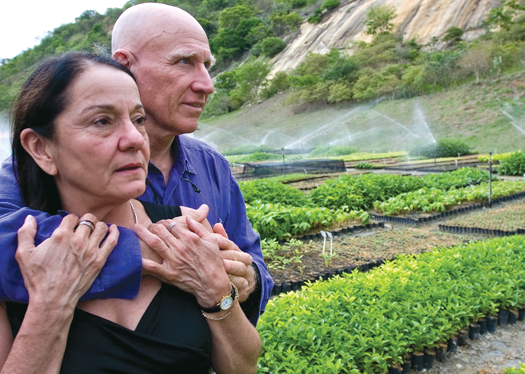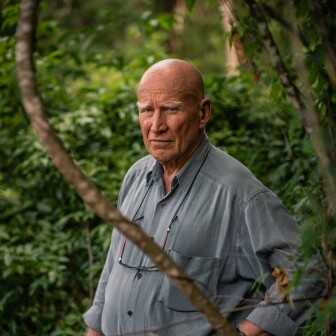Introduction
Instituto Terra emerged from personal tragedy and global vision. Sebastião Salgado, renowned for his stark photography of human suffering, returned to his family’s degraded farm in the 1990s, devastated by the loss of its once-lush forests [G5]. With Lélia, he transformed 600 hectares into a reforestation pioneer, planting millions of native trees and fostering ecosystem recovery [1].

By 2025, the institute’s scope has expanded, influencing broader initiatives like the Terra Doce program for spring restoration [2]. Salgado’s passing in May 2025 has amplified global tributes, positioning the project as a “global movement” for restoration [G2]. However, analyses from degrowth perspectives question if it truly challenges industrial agriculture or merely provides a feel-good illusion [Planet Keeper Report]. This overview sets the stage for a balanced examination of its ecological, social, and systemic impacts.
Ecological Achievements and Biodiversity Revival
Instituto Terra’s core success lies in measurable environmental restoration. Over its history, the project has planted more than 7 million trees, with 2.5 million seedlings from 297 native Atlantic Forest species at the Bulcão Farm Private Reserve alone [4]. This has led to the return of diverse fauna, including ocelots, insects, birds, and reptiles, signaling restored food chains [5]. Water restoration is equally impressive: eight natural springs revived on the Salgado property, with the Terra Doce program targeting 4,200 springs via 2 million trees in agroforestry systems [1][2].


Recent studies underscore these gains. Restor.eco’s 2025 report documents biodiversity resurgence, using timelapse imagery for monitoring [5]. Survival rates for saplings have soared from 50% to 90% through refined nursery techniques, like controlled stress exposure [3]. Experts hail this as a “mini-oasis” in a biome where only 8% of original forest remains [1]. on social media, posts celebrate the revival of 172 bird and 33 mammal species, inspiring viral tributes post-Salgado’s death [G15][G17]. These figures demonstrate tangible climate mitigation, aligning with UN restoration goals [G4].
Community Engagement and Educational Outreach
Beyond ecology, Instituto Terra emphasizes human elements. The Terrinhas program has reached over 80,000 children and teachers, with 560 students completing a seven-month course in 2024 [2]. This integrates socio-environmental education into local schools, fostering sustainable practices [2]. Funding, including $2–3 million from the Salgados personally, supports these efforts [3].
Analyses praise the project’s community focus. Global Voices notes its role in educating for conservation, making it a replicable model [2][G1]. X discussions highlight job creation and empowerment, with tributes framing it as reviving “life” through agroforestry [G15]. Yet, indigenous rights receive scant mention; while the project aids rural producers via cacao and coffee integration [2]

, experts argue it may overlook traditional knowledge in favor of top-down approaches [Planet Keeper Report]. This gap underscores a need for inclusive equity in restoration.
Critical Perspectives: Scalability, Greenwashing, and Systemic Limits
While lauded, Instituto Terra faces critiques on depth and scale. High labor and seedling costs hinder replication, as noted in EcoAmericas’ 2020 analysis [1]. From degrowth viewpoints, it fails to confront “endless economic growth” driving deforestation, potentially enabling greenwashing by not challenging agribusiness [Planet Keeper Report]. Salgado’s celebrity amplified visibility—earning TIME100 recognition [G3]—but some see it as performative, overshadowing indigenous-led efforts [Planet Keeper Report].
Balanced views emerge: Mongabay’s 2025 obituary views it as symbolic yet substantive [7][G2]. X trends post-death emphasize inspiration without direct greenwashing accusations, though discussions warn of commercial reforestation pitfalls [Planet Keeper Report, X posts]. Funding from partners like KfW raises corporate tie concerns, but evidence shows genuine intent [G5]. Original insights suggest a “restorative individualism” model: effective locally, but insufficient systemically without policy integration [Planet Keeper Report].
Constructive Solutions and Future Directions
Instituto Terra offers practical solutions under study. Its multi-stage reforestation—starting with fast-growing species for soil protection, then diverse natives [4]—provides a blueprint for scalability. The Terra Doce program’s agroforestry enhances economic viability for farmers, blending restoration with livelihoods [2]. Ongoing monitoring and education ensure long-term viability [5][2].
Experts advocate policy adoption: urging Brazil’s government to incentivize similar models amid volatile deforestation rates [1][6]. Emerging trends include summits like the Integrated Conservation event in late 2025, potentially boosting funding [G4]. Degrowth proponents propose hybrid approaches integrating indigenous rights and anti-growth economics [Planet Keeper Report]. Active initiatives, like SOS Mata Atlântica’s regeneration studies, highlight incentives for recovery .
Key Figures
- Total trees planted: Over 7 million trees planted by Instituto Terra since inception[2].
- Native species reforested: 2.5 million seedlings from 297 native Atlantic Forest species planted at the Bulcão Farm Private Reserve[4].
- Water sources restored: Restoration of eight natural springs on the Salgado family property, with the broader Terra Doce program aiming to restore 4,200 springs by planting 2 million trees through agroforestry[1][2].
- Biodiversity impact: Thousands of hectares restored, with documented return of native fauna (e.g., ocelots, insects, birds, reptiles)[5].
- Community reach: Over 80,000 children and teachers reached by the Terrinhas environmental education program; 560 students participated in a 7-month course in 2024[2].
- Funding: $2–3 million personal investment by Sebastião and Lélia Salgado over 20 years[3].
- Survival rate: Improved from 50% loss in early years to 90% survival rate for saplings after refining nursery techniques[3].
Recent News
- Terra Doce Program Expansion (2025): Instituto Terra’s Terra Doce program is in its first five-year phase, targeting ecological recovery of 4,200 springs in the Rio Doce basin through agroforestry with cacao and coffee, supporting small- and medium-sized rural producers[2].
- Educational Outreach (2024): 560 students participated in a seven-month environmental education course, part of the Terrinhas project’s ongoing efforts to integrate socio-environmental education in local schools[2].
- Global Recognition (2025): Salgado’s death in 2025 prompted renewed global attention to his legacy, with major outlets highlighting both the scale of reforestation and the project’s symbolic importance as a model for ecological restoration[7].
Studies and Reports
- EcoAmericas (2020): Notes the Salgado family’s RPPN as a “mini-oasis” in a state where only 8% of Atlantic Forest remains, with visible hydrological recovery (eight springs restored). Identifies high labor and seedling costs as a barrier to replication[1].
- Restor.eco (2025): Documents the return of biodiversity in reforested areas, including insects, birds, mammals, and reptiles, indicating restored food chains. Highlights the Olhos D’Água initiative, which has restored over 2,000 springs, and emphasizes the importance of monitoring for full ecological recovery[5].
- Google Arts & Culture (undated): Details the multi-stage reforestation strategy, starting with fast-growing species for soil protection, followed by enrichment with diverse native species to boost biodiversity[4].
Technological Developments
- Nursery Techniques: Instituto Terra refined its nursery practices to subject saplings to controlled stress (reduced watering) before planting, increasing survival rates from 50% to 90%[3].
- Agroforestry Systems: The Terra Doce program integrates cacao and coffee with native and fruit trees, enhancing soil resilience and water resources while providing economic opportunities for local farmers[2].
- Monitoring and Education: Use of environmental education programs (Terrinhas) and likely remote sensing (implied by Restor.eco’s timelapse imagery) to track restoration progress and engage communities[2][5].
Recent Regulations and Policies
- No direct evidence of new 2024–2025 Brazilian federal policies specifically impacting Instituto Terra in the provided sources.
- The project is framed as a model for public policy, with advocates urging the government to adopt similar approaches for Atlantic Forest restoration[1].
- Broader context: Brazil’s environmental policy remains volatile, with recent increases in deforestation rates despite earlier successes; initiatives like the Amazon Fund and REDD+ continue but face political and economic challenges[6].
Ongoing Projects and Initiatives
- Terra Doce Program: Active, multi-year agroforestry and spring restoration initiative in the Rio Doce basin[2].
- Terrinhas Environmental Education: Continues to expand, reaching tens of thousands of students and teachers in the region[2].
- Scientific Research: Ongoing monitoring of biodiversity return and ecosystem services (e.g., water table recovery, soil health)[1][5].
Critical Perspectives and Limitations
- Scalability: High costs of labor and seedlings are cited as major barriers to replicating the model at scale[1].
- Systemic Issues: The project does not directly challenge industrial agriculture’s role in deforestation, focusing instead on demonstrating that restoration is possible and providing a replicable model[1][2].
- Celebrity Influence: Salgado’s fame has brought global attention and funding, but the project’s technical and educational components are managed by a professional team, suggesting substantive ecological work beyond mere symbolism[2][3].
- Local Impact: The initiative creates economic opportunities for rural communities through agroforestry and education, but there is no evidence in the provided sources of direct engagement with indigenous land rights or degrowth economics[2].
- Long-term Viability: The project’s focus on education, scientific monitoring, and community involvement suggests a commitment to sustainability, but its dependence on continued funding and political stability in Brazil remains a risk[2][5].
MAIN SOURCES:
- EcoAmericas (2020): Analysis of Instituto Terra’s ecological and hydrological impacts, barriers to replication, and policy recommendations https://www.ecoamericas.com/issues/article/2020/3/444CA184-06F2-48E9-8AC1-4AF8245EA4C9 [1].
- Global Voices (2025): Details on the Terra Doce program, educational outreach, and Salgado’s vision for the project as a replicable model https://globalvoices.org/2025/06/05/from-barren-land-to-thriving-forest-the-story-of-photographer-sebastiao-salgados-instituto-terra-in-brazil [2].
- KfW Stories (undated): Personal investment figures, technical challenges in early years, and refined nursery practices https://www.kfw.de/stories/salgado-2.html [3].
- Google Arts & Culture (undated): Overview of reforestation strategy, species diversity, and stages of forest recovery https://artsandculture.google.com/story/it-is-possible-to-recover-the-atlantic-forest-instituto-terra/kQUxZ3P7Ikh-LA?hl=en [4].
- Restor.eco (2025): Scientific assessment of biodiversity return, monitoring methods, and the Olhos D’Água initiative https://about.restor.eco/blog/the-return-of-flora-and-fauna-in-the-atlantic-forest [5].
- KfW Stories – Environment (undated): Broader context of Brazilian forest policy, Amazon Fund, and REDD+ https://www.kfw.de/stories/environment/nature-conservation/rain-forest-protection/[6].
- Mongabay (2025): Obituary and legacy piece highlighting global impact and symbolic importance of Salgado’s work https://news.mongabay.com/2025/05/photographer-sebastiao-salgado-planted-a-forest-and-grew-a-global-movement/[7].
- Sotheby’s (undated): Interview with Salgado on the philosophy behind Instituto Terra https://www.sothebys.com/en/articles/photography-is-the-memory-of-our-society-a-conversation-with-sebastiao-salgado [8].
—
Summary:
Instituto Terra, under Sebastião Salgado’s leadership, has achieved measurable ecological restoration—millions of trees planted, biodiversity returning, and water sources revived—with robust educational and community components. Its technical refinements and monitoring demonstrate genuine ecological intent, not just celebrity spectacle. However, scalability is limited by cost, and the project does not directly confront systemic drivers of deforestation. It stands as a proven, replicable model for localized restoration and environmental education, but not as a systemic challenge to Brazil’s broader environmental injustices or growth-based economies.


